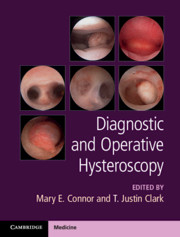Book contents
- Diagnostic and Operative Hysteroscopy
- Diagnostic and Operative Hysteroscopy
- Copyright page
- Dedication
- Contents
- Videos
- Contributors
- Chapter 1 An Introduction to Hysteroscopy
- Chapter 2 Anatomy and Physiology of the Uterus
- Chapter 3 Infrastructure and Instrumentation for Hysteroscopy
- Chapter 4 Diagnostic Hysteroscopy: Accuracy and Interpretation of Findings
- Chapter 5 Hysteroscopy Techniques and Treatment Settings
- Chapter 6 Analgesia and Anaesthesia for Hysteroscopy
- Chapter 7 Indications for Hysteroscopy
- Chapter 8 Hysteroscopic Electrosurgery
- Chapter 9 Complications of Hysteroscopic Surgery
- Chapter 10 Hysteroscopic Endometrial Polypectomy
- Chapter 11 Endometrial Ablation
- Chapter 12 Hysteroscopic Management of Fibroids
- Chapter 13 Hysteroscopic Sterilisation
- Chapter 14 Management of Congenital Uterine and Vaginal Anomalies
- Chapter 15 Hysteroscopic Management of Uterine Adhesions
- Chapter 16 Unusual Hysteroscopic Situations: Caesarean Niche and Retained Placental Tissue
- Chapter 17 Audit, Data Collection and Clinical Governance in Hysteroscopy
- Chapter 18 Training in Hysteroscopic Skills
- Chapter 19 Research and New Developments in Hysteroscopy
- Index
- References
Chapter 9 - Complications of Hysteroscopic Surgery
Published online by Cambridge University Press: 10 September 2020
- Diagnostic and Operative Hysteroscopy
- Diagnostic and Operative Hysteroscopy
- Copyright page
- Dedication
- Contents
- Videos
- Contributors
- Chapter 1 An Introduction to Hysteroscopy
- Chapter 2 Anatomy and Physiology of the Uterus
- Chapter 3 Infrastructure and Instrumentation for Hysteroscopy
- Chapter 4 Diagnostic Hysteroscopy: Accuracy and Interpretation of Findings
- Chapter 5 Hysteroscopy Techniques and Treatment Settings
- Chapter 6 Analgesia and Anaesthesia for Hysteroscopy
- Chapter 7 Indications for Hysteroscopy
- Chapter 8 Hysteroscopic Electrosurgery
- Chapter 9 Complications of Hysteroscopic Surgery
- Chapter 10 Hysteroscopic Endometrial Polypectomy
- Chapter 11 Endometrial Ablation
- Chapter 12 Hysteroscopic Management of Fibroids
- Chapter 13 Hysteroscopic Sterilisation
- Chapter 14 Management of Congenital Uterine and Vaginal Anomalies
- Chapter 15 Hysteroscopic Management of Uterine Adhesions
- Chapter 16 Unusual Hysteroscopic Situations: Caesarean Niche and Retained Placental Tissue
- Chapter 17 Audit, Data Collection and Clinical Governance in Hysteroscopy
- Chapter 18 Training in Hysteroscopic Skills
- Chapter 19 Research and New Developments in Hysteroscopy
- Index
- References
Summary
Hysteroscopy is safe and effective and can greatly reduce morbidity and enhance recovery compared with conventional open procedures. Furthermore, it can minimise the inherent risks of general anaesthesia and hospital admissions because many hysteroscopic procedures can now be delivered in non-anaesthetised women in an outpatient setting. The overall complication rate of hysteroscopic intervention is estimated to be less than 1% [1, 2], of which half is due to serious complications, namely fluid overload, uterine perforation and upper genital tract haemorrhage. Complications occur during access and entry into the uterine cavity or during the diagnostic or operative procedure. Complication rates are higher with operative hysteroscopy (0.95%) compared with purely diagnostic procedures (0.13%) [1]. These risks are highest with more complex hysteroscopic surgery such as myomectomy and adhesiolysis and lowest with purely diagnostic procedures.
- Type
- Chapter
- Information
- Diagnostic and Operative Hysteroscopy , pp. 109 - 117Publisher: Cambridge University PressPrint publication year: 2020



